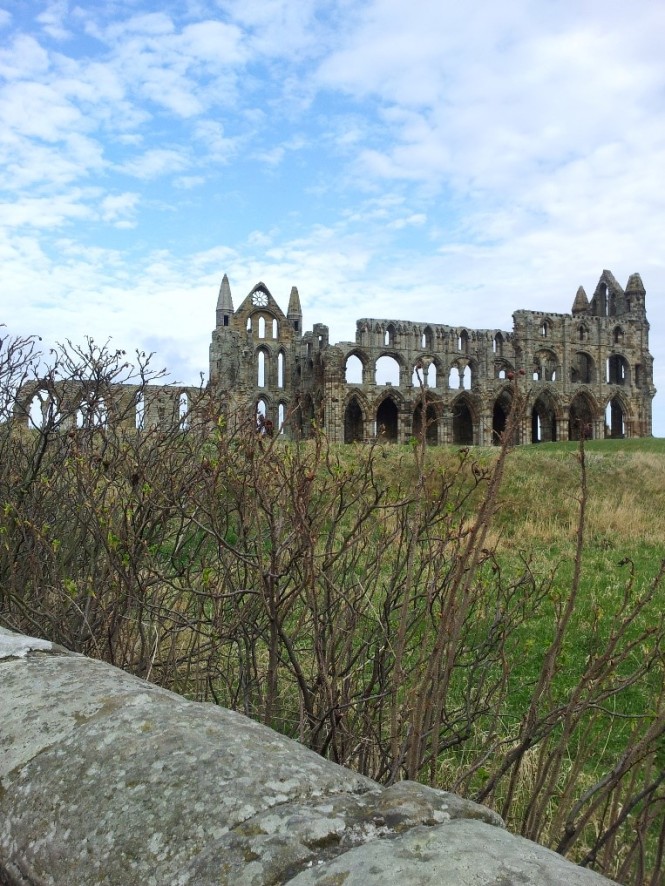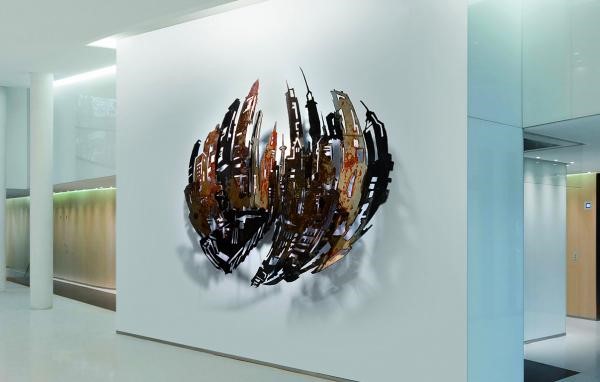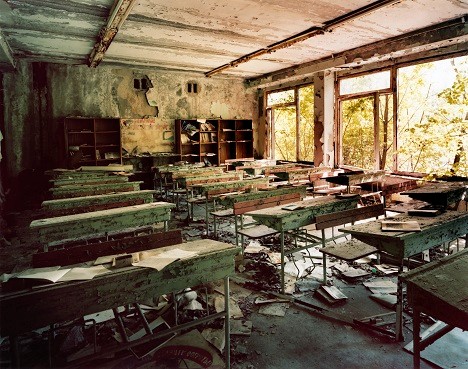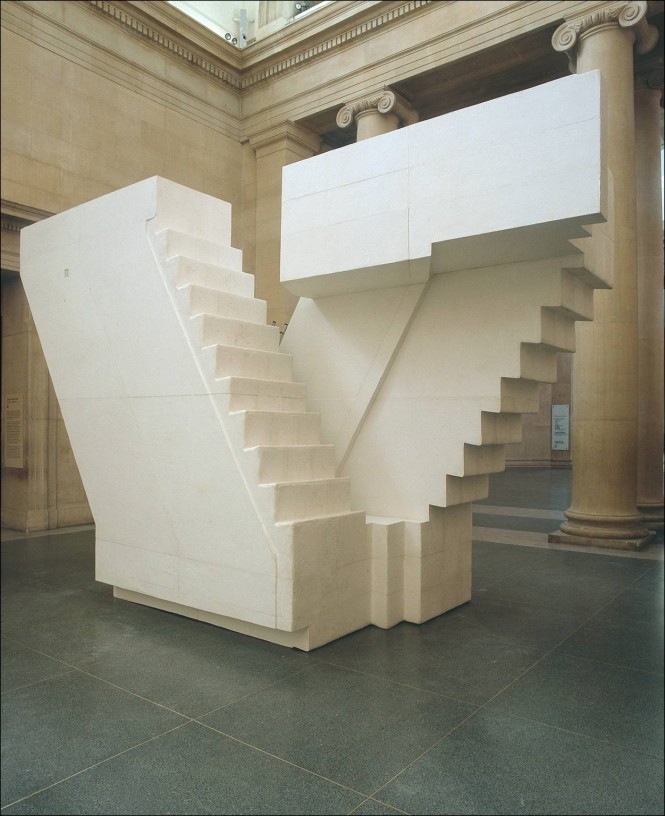Modern castles in the sky and ruins on the ground.
An essay about four architecturally inspired artists, who in turn, have inspired and informed my art. NEGOTIATED ESSAY: 3000 WORDS
Module Name: Engaging with Art: Reading,
Thinking & Writing in Year Two
Module Code: FAE2013-N
Module Tutor: Jared Pappas-Kelley

‘I felt that the decrepit state of these once magnificent buildings, with their broken gutters, walls blackened by rainwater, crumbing plaster revealing the coarse masonry beneath it, windows boarded up or clad with corrugated iron, precisely reflected my own state of mind’.
(W.G. Sebald, Austerlitz 2001)
Introduction
This essay will discuss the work of four contemporary artists in relation to my own studio practice, comparing and contrasting their work to my own. The four artists that have been addressed are Laura Oldfield Ford, Frederic Daty, Jane and Louise Wilson and Rachel Whiteread. They have been chosen because I find their work inspirational and also I feel I can learn a lot from their method of working which I feel will benefit my own processes of producing art.
Chapter 1 : Laura Oldfield Ford
My first contemporary artist I am going to explore is Laura Oldfield Ford. Her aim for her Coventry project was an “investigation into the marginal, a process of burrowing under the heritage version of England to uncover the repressed psyche of a land. I want to ask how far are the marginal political ideologies that emerge in the fraying edges of our cities a product of that environment and what new discourses are fomenting in the liminal zones of the commuter belt.” These aims are similar to mine as I also am interested in English Heritage and the repressed state of many architectural pieces. However Oldfield Ford tries to recover the history of repressed modern buildings whereas I go on a quest of discovery of castles and ruins. English Heritage is a particular interest of mine as it a highly sort out tourist attraction whereas more modern ruins are seen as neglected areas that are commonly described as eyesores to the public.
Laura Oldfield Ford conducted her work by taking short journeys through specific sites of cultural and socio-political significance relating to radical counterculture, land contestation and marginal political ideologies within Surrey. She produced paintings as well as a written text pieces (see table of illustrations image 1). Areas included: derelict airfields (Wisley), abandoned military sites (Deepdene Bunker, Dunsfold Aerodrome), land-grabbed commons (St. George’s Hill, Cobham), islands in the Thames (Ham Island, Eel Pie Island, Swan Island, Alcott House), and housing schemes (Cambridge Road and Kingsnympton Estates) . Her work predominantly concentrates on modern ruins. There are elements of this in my own project, however I also include traditional old ruins of castles and abbeys. I feel these traditional ruins express elements of English history, however I understand that modern ruins such as housing schemes abandoned military sites may be easier to relate to because they can be seen everywhere but are chosen to be ignored and not seen as a piece of history compared to castles. I chose to portray older architecture in my own work as I feel they are more likely to be forgotten about as they are not as common in the everyday venture.
Explaining the interests and influences of her work Laura Oldfield Ford has said: ‘I am interested in places that are derelict, laid to waste. I’m interested in how places respond to economic fluctuations, and how the potential for radically different ways of engaging with those spaces can emerge’ . I have the same interest in derelict and wasted land however my work does not deal with the economic aspect of ruins. In the same interview Oldfield Ford stated ‘Already many of the 60s and 70s builds are seen as failures and ruins, they have been starved of investment and left to fall into a state of chronic disrepair and the architecture has been wrongly maligned in most cases’ This can be seen in the Brutalist Movement which is from the 1960s and 1970s and includes a prominent stance of commonly described as unsightly concrete eye saws of architecture abandoned due to economic downfalls. This particular movement has influenced me in my view of ruins and it widens my initial knowledge of ruins being only ancient castles and abbeys. I am particularly interested in the raw structure which can be seen inside a partially destroyed tower block from this era to which I have produced one of my metal structures on.
Oldfield Ford’s method of working is to draw over photographs of broken down buildings with a history behind them in ink, this as a form of protest to modern architects who she feels are pulling down history to build lifeless modern buildings. This is similar to my own way of working except that I aim to show the wrecked buildings in a more positive light. Many of the buildings I portray are still in use, for example as museums pieces like Whitby Abbey, whereas Oldfield Ford’s buildings are empty and lifeless.
Another area that is different is Laura Oldfield Ford uses photography with written text over and also drawing whereas I produce sculptural models made from metal and plaster, along with line drawings. I feel because she only uses pictures the audience does not get a full sense of the building, in particular its connection to space. However it can be said that her black and white photographs are more serious whereas models are more playful, lessening the message of the loss of history in architecture destruction. Oldfield Ford also produced a project of drawings on watercolour paper, made in pencil and chalk with acrylic ink. These pieces have similar margins to mine as she predominantly uses greys, black and white shadings whereas I keep my line drawings purely black and white. I feel only using basic colours does not distract from the architecture of the drawing. In her drawing of M6 Junction 9, Bescot 6, 2011(see table of illustrations image 2) she has added some bright colours on a small area of the drawing. I like this as it adds a sense of graffiti to the derelict modern ruin, and I did try adding colour to my own project. However I found it did not have the same effect as the pure graphite line drawings since these also lend a sense of architectural blue print drawings of a building.
Chapter 2 : Frederic Daty
The second contemporary artist I have chosen is Frederic Daty who is interested in the relationship between humans and their environment. He produces wall sculptures made of light raw steel plates cut, weathered, sanded and welded. The natural colour is preserved and the work is then hung with simple hooks. His work keeps only the structure, the skeleton, seen in raw steel and he shows the energy of the work shown through the shadows and light cascading off it. His work is sectioned into a number of themes: ‘Birdview’, Bubble City’, ‘Root City’, ‘Lit Cocoon’ and ‘Vegetal Web’. To deal with one theme of the work in more depth Bubble City’ represents a single celled organism from the perspective of a wide angle, so that the organism becomes seen as a giant bubble (seen in the table of illustrations image 3). The city seen in the wall hanging takes on the shape of a protective cocoon which invites the viewer to enter the walls and explore the city but on a much smaller scale seen as a bubble. I am particularly attracted to the way in which he creates shapes from metal to portray his ideas. I like the clean edges of the work which give them a smooth look. It has inspired me to attempt to create more interesting shapes in my own metal work.
In an autobiographical writing on Fredric Daty’s website he explained the concept of his work,
‘Confronted with an overload of images, an invasion of colours, a pouring out of futile information, my goal is to reinterpret the reality and break it down into its fundamental pieces. The medium I have chosen is a raw, primal material, without artifice and faddish coverings. I would like my work to be the opposite of a cluttered mind and soul, wrapped in superficial layers. My work contains stylized shapes and forms in an effort to be simple, clear and pure.’
Both Daty’s and my own work are similar in as much as we both portray architectural scenes in a stripped back sense, only involving the raw construction through metal sculptures. Daty produces large scale wall hangings which, while striking, are abstract, whereas I produce 3D sculptures which are more lifelike and realistic of architectural scenes. It can be said, however, Daty’s more abstract and less lifelike work draws the audience in as they attempt to work out what the metal structure is portraying.
In his first UK solo show 2014 called Trinity involved iconic London city scenes were interpreted in metal sculptures – from Westminster and Big Ben, to Piccadilly Circus and stations across the capital, such as Borough and Canary Wharf. Trinity explored the idea of stripping the scene down to its structure, presenting the city as a skeleton carved from raw hand-cut steel. On the collection, Daty states:
“I would like my work to be the opposite of a cluttered mind and soul. Simplicity in the clearly defined shapes and lines is first meant to be pleasing to the eye, but its purpose is to make the viewer stay, rest, and contemplate the subtleties in their own lives, to enter into their own memories and reflect in the spiritual realm, things we can only do if we are still”
It is clear to me that Daty has kept his work to one medium to keep it simple and easy for the viewer to understand and digest. This approach can be good as not everyone has the time to stand and try and work out the meaning of an artwork. In this way more people will see the work as pleasing to the eye. By contrast my work involves a number of mediums from sculptures and line drawings which takes longer for the viewer to digest. Both approaches work however I can argue using more than one medium as it can show more thought has been put into the work as I have looked at how the idea can be expressed in different methods.
Chapter 3 : Jane and Louise Wilson
The work from young British Artists and identical twins Jane and Louise Wilson explore different abandoned landscapes from former Nazi interrogation rooms to failed redevelopment areas. Their work includes multi-screen video installations and photography of altered states that have once been populated by people, some with evil histories such as Nazi leader’s military bunkers but now have been left abandoned therefore leaving lingering energy and a sense of paranoia (see in table of illustrations image 4). They are most famous for their project based on Chernobyl. They visited the area several times to gather as much primary evidence as possible. Describing their visit to Chernobyl, they have said ‘When you visit Chernobyl. Which is quite amazing due to the voracity of nature where there was once a road now there are plants and weeds. All that green is quite shocking for that first visit.’ Both the twins and I gather the primary evidence from the site to enhance our knowledge of the environment. I also believe it is important to visit the landscape around which you intend to base your artwork as it will give a close insight into the environment and is the best source of evidence.
The twins’ work include photographs of the interior of the buildings whereas I prefer to concentrate on photographs of the exterior of abandoned buildings. However I feel the approach to photographing inside the building does give a stronger sense of loss because the picture scenes which should be busy and full of people for example classrooms are now empty (see table of illustrations images 5). It can be also said that their work using insides of buildings provides more and therefore can be said to be more interesting as they tell more of a story. However, it is also true that images of buildings taken from the outside, for example the photographs of the castles I have taken, show more secrets and are ambiguous as you cannot see inside, such as seen as the images of Whitby Abbey. I take inspiration from their work as it makes me think of the style of photography I have used to base my line drawings as it extends my thinking further than what you see initially.
According to an article in the Guardian describing the twins’ work installed in the Whitworth Art Gallery, Manchester 2013. ‘It is hard not to feel the sadness of the world here, the misery of the modern age’ . It can be said that time is needed for any growth or development, however time can be bad for buildings as they may change drastically, become no longer inhabitable, something seen in both my work and also the twins’. However there are differences in the reasons why these landscapes have been ruined, Jane and Louise’s work portrays results of a horrificaly and purposely carried out action from nuclear bomb whereas the destruction of my work is through years of neglect, approaches which together pose of the question of which might be worse.
Chapter 4 : Rachael Whiteread
A fourth and final artist that I am interested in is Rachel Whiteread. Her sculptures are casts made from materials like concrete, plaster, resin, rubber, polystyrene, polyester resin and pigmented urethane and urethane filler. The sculptures represent the negative spaces found within architecture, rooms or, staircases (see table of illustration image 6), furniture etc., thus converting them into positive spaces.
The architecture, furniture is destroyed in the making of the artworks, as they have to be taken apart in order to reveal the artworks within them.
In the first stage of Whiteread work she produces vast amounts of 2D work drawings, photographs etc., these are seen as studies made of an exploration of a theme that will eventually link to her final piece of work.
Like Rachel Whitehead, I also like to take vast amounts of photographs that may not necessarily relate to my final pieces of artwork. In my case these aid my creativity, as I explore through photography and pencil drawings, my chosen architectural themes, which are architectural ruin and decay, both in historical and newer buildings, as Whitehead’s photography does. Whiteread will photograph ruins in Greece and terraced houses in Britain concentrating on external structures attached to architecture, such as metal fire escapes, in preparation for creating her architectural inside out pieces.
Most of the objects she uses for casting her pieces, cannot be saved as they are ruined in the process of creation. They are used as moulds that surround the negative space, which is then filled with concrete, which originally had only held air, as in the case of ‘House’. Within the void of the building, room or furniture, she builds an internal skin to hold the concrete, so that the sculpture is actually hollow. But the sculpture still shows in detail the walls, light plugs, windows etc. of the house. In the case of the ‘House’ 1993, it was demolished bit by bit once the interior of the house had been cast which took a month, and the concrete had set which took a further 10 days.
‘House’ (1993) is Whiteread’s most famous piece. It is her largest and most ambitious work. It was her first public sculpture and was responsible for transforming her from a relatively unknown artist to a household name (see in table of illustrations image 7).
The idea for ‘House’ came to her three years earlier a few weeks after completing her ‘Ghost’ work, which involved the concrete casting of one room’s negative space. ‘House’ was a continuation of her earlier work ‘Ghost’, (see in table of illustrations image 8) as the elements of that became an integral part of this work.
Rachael Whiteread was awarded the Turner Prize on the 23rd November 1993 for House, the very day that Bow Council decided not to grant the ‘House’ the stay of demolition order. Whiteread managed to delay the demolition until 12th January 1994, so it had a chance to be seen by many more people before it was destroyed, she had wanted it to stay and become part of the fabric of the neighbourhood, but still to be only a temporary structure.
‘House was a mute memorial for the area and its history, and a tomb that visualised the darker side of domestic life. But it also came to be a pawn in the political discourse, and was called variously a ‘bunker’, and ‘eyesore’, a ‘mausoleum’, and an ‘exceptional work of art’. It was clever yet simple, a monument to thoughts and dreams and sensations a human-sized foil to the faceless scale of Canary Wharf, And suddenly it was gone.’
The sculpture House finally became neglected and covered in graffiti and housing wildlife. Sadly all the effort Whiteread put in over the three and a half years of creating the idea and the four months it took to build, only thirty minutes were needed for the sculpture to be taken down and destroyed.
Conclusion
As an overall conclusion my work is an insight into traditional architecture for examples castles and abbeys, and how they are now viewed as ruins because of their years of decay and deterioration. However this is very rarely covered by contemporary artists, as such areas are now portrayed in a more modern sense and ruins are seen in derelict buildings from the Brutalist Movement in the 1960s and 1970s. Art that covers castles and ruins are more traditional artists such as William Turner from the 18th Century and John Piper in the 1970s and 1980s. I think the Historical Ruins of today that have survived the ravages of time, are seen as precious and of great value, as tourist attractions to generate money in order to preserve and restore the said architectures. As opposed to modern ruins, which are seen as, a blot on the landscape and structurally hazardous, and can be visited free and carry no value at all to society. I also feel both modern and ancient ruins, can be equally a thing of beauty, architecturally and visually, and in my present Studio Practise modules I am trying to convey this message via my varied artworks in plaster, print, metal work and illustrations.
I have found monumental inspiration from the four artists I have explored in this essay, all in different ways. Frederic Daty has inspired me to develop my metal work and create more complex designs using difficult techniques of cutting and welding. Work from both Laura Oldfield Ford and the Wilson twins have inspired me to look further than castles and explore other formats of ‘destruction’ and ‘ruins’. Finally Rachel Whiteread looks at the use of negative space in a structural sense therefore this widens my scope on my own workings of negative space done purely on my line drawings.
Word Count 3,258
Table of illustrations
Images
Front cover image: – My own photograph of Whitby Abbey.
Image 1:

Laura Oldfield Ford M6 Junction 9, Bescot 2011
Above image: Laura Oldfield Ford Ferrier Estate (detail) 2010 http://www.stanleypickergallery.org/news/laura-oldfield-ford-stanley-picker-fellow-at-tate-britain/ [date and time accessed 23/01/2016, 4.45pm]
Laura Oldfield Ford: Stanley Picker Fellow at Tate Britain Spring 2014
Ruin Lust until 18 May 2014
Image 2:

Laura Oldfield Ford M6 Junction 9, Bescot 2011
Above image: Laura Oldfield Ford M6 Junction 9, Bescot (2011) chalk, acrylic and ink on watercolour paper.
http://www.stanleypickergallery.org/news/new-stanley-picker-fellowship-appointments-2013/
[date and time accessed 23/01/2016, 5.17pm]
In the Collection of Moses Luski
Image 3:

Frederic Daty Bubble City- Ville Bulle 5#5
Bubble City- Ville Bulle 5#5, size: 120/109/12cm
http://www.maison-objet.com/en/paris/exhibitors/september-2015/frederic-daty?offset=55
[date and time accessed 05/02/2016 10:45am]
Image 4:

Jane and Louise Wilson Bunker mentality: ‘Azeville’ (2006)
Bunker mentality: ‘Azeville’ (2006) by Jane and Louise Wilson Jane and Louise Wilson/Tate
http://www.independent.co.uk/arts-entertainment/art/features/broken-britain-ruins-inspire-at-the-tate-britain-9179851.html [date and time accessed 23/01/2016, 5.29pm]
Image 5:

Jane and Louise Wilson, Atomgrad (Nature Abhors a Vacuum), 2010
Jane and Louise Wilson, Atomgrad (Nature Abhors a Vacuum), 2010
http://www.creativetourist.com/articles/art/manchester/jane-and-louise-wilson-at-the-whitworth-homage-to-chernobyl/ [date and time accessed 05/02/2016 at 10:30am]
Image 6:

Rachel Whiteread Untitled (stairs) 2001
Untitled (Stairs) 2001
http://www.tate.org.uk/art/artworks/whiteread-untitled-stairs-t07939 [date and time accessed 23/01/2016, 4.07pm]
Image 7:

Rachel Whiteread House 1993
House (1993), Rachel Whiteread © Rachel Whiteread / Photo Sue Omerod
http://www.apollo-magazine.com/house/ [date and time accessed 23/01/2016, 3.38pm]
Image 8:

Rachel Whiteread Ghost 1990
Ghost 1990
http://www.saatchigallery.com/aipe/rachel_whiteread.htm
[date and time accessed 23/01/2016. 4.33pm]
Ghost 1990 Plaster on steel frame 269 x 355.5 x 317.5 cm 106 x 140 x 125″
Bibliography
Primary Sources [e.g. Exhibitions, Contact artist directly, interviews etc.]
Exhibitions
Daty, Frederic .Exhibition Saturday 31st October 2015, opening night, Trinity Exhibition. Castle Galleries, 19 Castlegate, the Coppergate Centre, York.
Contact artist directly
Daty, Frederick. Facebook and E mail: frederic@daty.org
Oldfield-Ford, Laura. E mail: Lauraoldfield@gmail.com
Secondary Sources [e.g. Books, Websites, Journals, Films etc.].
Books
Oldfield-Ford, Laura
Oldfield Ford, Laura. Savage Messiah. Image and text. London. Published by Verso, 2011.
Books
Whiteread, Rachael
Dillon, Brain. Ruin Lust. Image and text. London: Tate Publishing, 2014. [Pages 30, 31]
Hal Foster, Rosalind E. Krauss. Art since1900: modernism, anti-modernism, postmodernism. Image and text. London. Published by Thames and Hudson Ltd, 2012. [Pages. 681-683]
Mullins, Charlotte. Rachel Whiteread. Image and text. London: Tate publishing, 2004. [Pages. 38–57]
Books
Wilson, Jane and Louise
Corrin, Lisa G. Jane and Louise Wilson. Image and text. London. Published by Serpentine Gallery. 1999. Catalogue published to accompany the exhibition Jane & Louise Wilson. 14th September – 31st October 1999.
Dillon, Brain. Ruin Lust. Image and text. London: Tate Publishing, 2014. [Pages 52-55]
Millar, Jeremy and Doherty, Claire. Jane and Louise Wilson, with essays by Jeremy Millar and Claire Doherty. Image and text. London. Published by Ellipsis London Limited. 2000.
Websites
Corden, Gerry. ‘Estate: an inaccessible wilderness, mundane and sublime: Gerry in Art, Nature & Environment’
https://gerryco23.wordpress.com/2014/01/21/soft-estate-an-inaccessible-wilderness-mundane-and-sublime/ [date and time accessed: 11/12/2015, 11.41am]
Daty, Frederic, Artists Home page shows his artwork themes, http://fredericdaty.com/en/home-4/ [date and time accessed 11/12/2015, 11.57 am]
Daty, Frederic ‘Trinity Exhibition’ http://www.eventbrite.co.uk/e/trinity-by-frederic-daty-exhibition-tickets-17761834124?aff=esv [date and time accessed 11/12/2015, 12.26 pm]
Daty, Frederic ‘Trinity’
Click to access Daty_TRINITY_Catalogue.pdf
[date and time accessed: 11/12/2015, 12.47 pm]
Oldfield Ford, Laura. ‘Stanley Picker Fellow Fine Art
http://www.stanleypickergallery.org/fellowships/laura-oldfield-ford/ [date and time accessed: 11/12/2015, 10.41 am]
Oldfield Ford, Laura. ‘The street is always the most important place’ http://www.tate.org.uk/context-comment/articles/laura-oldfield-ford-street-most-important-place [date and time accessed: 11/12/2015, 11.13 am]
Searle, Adrian (2012), Post-atrocity exhibition: Jane and Louise Wilson’s disturbing films. The Guardian 22 October 2012.
Wilson, Jane and Wilson, Louise (2013), Photographing the ruins of the future. El Pais 14 July 2013.